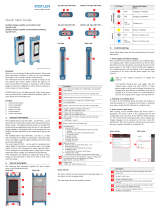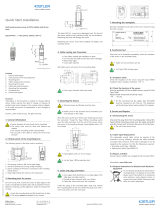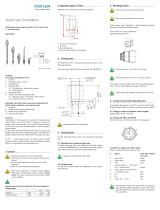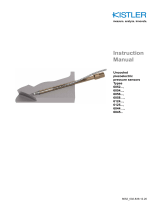Page is loading ...

Instruction
Manual
Quartz High-
Pressure Sensor
Type 6213B
6213B_002-022e-06.21


Foreword
6213B_002-022e-06.21 Page 1
Foreword
Thank you for choosing a Kistler quality product
characterized by technical innovation, precision and long
life.
Information in this document is subject to change without
notice. Kistler reserves the right to change or improve its
products and make changes in the content without
obligation to notify any person or organization of such
changes or improvements.
©1993 … 2021 Kistler Group. Kistler Group products are
protected by various intellectual property rights. For more
details visit www.kistler.com. The Kistler Group includes
Kistler Holding AG and all its subsidiaries in Europe,
Asia, the Americas and Australia.
Kistler Group
Eulachstrasse 22
8408 Winterthur
Switzerland
Tel. +41 52 224 11 11
info@kistler.com
www.kistler.com

Content
Page 2 6213B_002-022e-06.21
Content
1. Introduction ........................................................................................................................................ 3
2. Description.......................................................................................................................................... 4
2.1 Introduction ...................................................................................................................................... 4
2.2 Technical data (Table 1) ................................................................................................................ 6
2.3 Explanations to the technical data ............................................................................................... 7
2.3.1 Measuring range ............................................................................................................... 7
2.3.2 Calibrated range ............................................................................................................... 7
2.3.3 Overload ............................................................................................................................ 7
2.3.4 Temperature coefficient of the sensitivity ..................................................................... 7
2.3.5 Rise time ............................................................................................................................ 7
2.3.6 Operating temperature range ......................................................................................... 7
2.3.7 Tightening torque .............................................................................................................. 7
2.4 Functional principle ........................................................................................................................ 8
2.5 Typical applications ........................................................................................................................ 9
3. Installation ........................................................................................................................................ 10
3.1 General remarks ........................................................................................................................... 10
3.2 Suggested installation .................................................................................................................. 10
3.3 Proper use of the seal .................................................................................................................. 11
3.4 Tightening torque .......................................................................................................................... 13
3.5 Influence of the measuring bore ................................................................................................. 13
3.6 Preparing the measuring hole..................................................................................................... 15
3.7 Avoiding installation errors .......................................................................................................... 17
3.8 Reamer Type 1300A23................................................................................................................ 17
3.9 Firing with thermal protection ...................................................................................................... 19
3.9.1 Thermal Protection Shield Type 6563A ...................................................................... 20
3.9.2 Grease shield .................................................................................................................. 21
4. Different measuring rigs for ballistics ......................................................................................... 22
4.1 Cartridge chamber measuring .................................................................................................... 22
4.2 Case base adapter ....................................................................................................................... 24
4.3 Cartridge mouth measuring ........................................................................................................ 25
4.4 Measuring pressure anywhere along the barrel (Port Pressure) .......................................... 27
4.5 Pressure Bomb Measuring .......................................................................................................... 29
5. Operation .......................................................................................................................................... 32
5.1 Basic circuit of a measuring rig................................................................................................... 32
5.2 Range selection and threshold ................................................................................................... 33
5.3 Measuring High-Frequency Phenomena .................................................................................. 33
5.4 Measuring quasistatic phenomena ............................................................................................ 34
5.5 Directions and safety precautions .............................................................................................. 34
6. Calibration and maintenance......................................................................................................... 35
6.1 Calibration ...................................................................................................................................... 35
6.2 Recommended preliminaries ...................................................................................................... 36
6.3 Maintenance .................................................................................................................................. 36
6.4 Aids for calibration and maintenance ........................................................................................ 37
Total Pages 37

Introduction
6213B_002-022e-06.21 Page 3
1. Introduction
Please take the time to thoroughly read this instruction
manual. It will help you with the installation, maintenance,
and use of this product.
To the extent permitted by law Kistler does not accept
any liability if this instruction manual is not followed or
products other than those listed under Accessories are
used.
Kistler offers a wide range of products for use in
measuring technology:
Piezoelectric sensors for measuring force, torque,
strain, pressure, acceleration, shock, vibration and
acoustic-emission
Strain gage sensor systems for measuring force and
torque
Piezoresistive pressure sensors and transmitters
Signal conditioners, indicators and calibrators
Electronic control and monitoring systems as well as
software for specific measurement applications
Data transmission modules (telemetry)
Kistler also develops and produces measuring solutions
for the application fields engines, vehicles, manufac-
turing, plastics and biomechanics sectors.
Our product and application brochures will provide you
with an overview of our product range. Detailed data
sheets are available for almost all products.
If you need additional help beyond what can be found
either on-line or in this manual, please contact Kistler's
extensive support organization.

Quartz High-Pressure Sensor Type 6213B
Page 4 6213B_002-022e-06.21
2. Description
2.1 Introduction
The high-pressure sensor Type 6213B (Fig. 1) has been
developed especially for interior ballistic measurements
up to 10 kbar. It is also suitable for measuring dynamic
and quasistatic pressures in hydraulic systems.
The anti-strain construction renders the sensor largely
insensitive to different tightening torques and tensions at
the mounting location.
Thanks to its excellent linearity, the sensor is also well
suited for measuring low pressures.
The high-pressure sensor Type 6213B differs from the
familiar Kistler high-pressure sensors in its installation
dimensions. To accommodate the higher loading, its
screw-in thread as been enlarged from M10x1 to M12x1.
Fig. 1: High-Pressure Sensor Type 6213B

Description
6213B_002-022e-06.21 Page 5
The new front end has two major advantages:
The large contact surface reduces the pressure per
unit area despite higher tightening torques.
Because sealing is effected at the front end (Fig. 2),
the dead volume resulting from the installation is
particularly small – less than with the previous
shoulder sealing high-pressure sensors Types 6201
… 6211.
Fig. 2: Dimensions of the sensor Type 6213B and of the
sealing part

Quartz High-Pressure Sensor Type 6213B
Page 6 6213B_002-022e-06.21
2.2 Technical data (Table 1)
The technical data are described in more detail in subsection 2.3 below.
Range bar 0 ... 10 000
Calibrated range (with reference sensor) bar 0 ... 10 000
Calibrated range (with deadweight tester) bar 0 ... 8 000
Calibrated partial range bar 0 ... 1 000
Overload bar 11 000
Threshold bar <0.02
Sensitivity pC/bar –1.2
Natural frequency kHz >150
Rise time µs 2
Linearity %FSO <±0.5
Hysteresis %FSO <1
Acceleration sensitivity bar/g <0.006
Shock resistance axial g 25 000
transverse g 10 000
Temperature coefficient of sensitivity %/°C <+0.03
Operating temperature range °C –50 ... 200
Capacitance pF ≈5.5
Insulation resistance at 20 °C Ω >1013
Tightening torque N·m 40
Weight grams 18

Description
6213B_002-022e-06.21 Page 7
2.3 Explanations to the technical data
2.3.1 Measuring range
The data stated hold good for the corresponding
measuring range.
2.3.2 Calibrated range
With the deadweight tester the sensor is calibrated only
up to 8 000 bar. Testing up to 10 000 bar is done by
comparative measurements with a reference sensor.
2.3.3 Overload
The highest pressure to which the sensor may be
exposed without its data deviating outside the specified
tolerances.
2.3.4 Temperature coefficient of the sensitivity
Sensitivity change expressed in % per °C. If for example
the sensor is used at a temperature of 120 °C, the
sensitivity must be expected to increase by about 2 %.
2.3.5 Rise time
The rise time is taken to be the duration of a quarter
oscillation of the natural frequency of the sensor.
2.3.6 Operating temperature range
The temperature at the installation point must lie within
this range to enable continuous use of the sensor. The
gas temperatures may be higher (briefly).
2.3.7 Tightening torque
For the prescribed tightening torque it is guaranteed that
the sensor fits well enough to the sealing surface so that
an adequate sealing is guaranteed for the entire specified
pressure range.

Quartz High-Pressure Sensor Type 6213B
Page 8 6213B_002-022e-06.21
2.4 Functional principle
The pressure to be measured acts on the diaphragm,
which converts it into a proportional force. This force is
transmitted onto the quartz elements, which generate an
electrostatic charge under load. A contact spring picks up
this (negative) charge and leads it to the connector,
where its converted into a (positive) voltage by the
connected charge amplifier.
The tensions of the material acting onto the sealing part
of the sensor – caused by the tightening torque and
tensions at the mounting location – are not transmitted
onto the measuring element thanks to "anti-strain"
construction of the sensor.
Compared to the existing sensor Types 6201 ... 6211 the
sealing part has been transferred form the shoulder to
the front. By this measure the high loads, which act onto
the sensor at 10 000 bar, could be reduced. The
measuring pressure acts onto a relatively small surface
(≈28 mm2). The dead volume disturbing the
measurements is very small for this design (≈9.5 mm3).
The piezoelectric system is suited mainly for measuring
rapid dynamic and quasistatic pressure phenomena.
Static measurements over an unlimited period of time are
not possible.
Fig. 3: Schematic section through front part

Description
6213B_002-022e-06.21 Page 9
2.5 Typical applications
Typical applications for the high-pressure sensor Type
6213B are all kinds of pressure measurements in
hydraulic and ballistic systems. Only a short life may be
expected if it is employed in hydraulic systems where
steep pressure rises and numerous load cycles are
encountered (e.g. injection pumps).
Fig. 4: Pressure measuring on a gas pressure
measuring barrel (cartridge chamber)

Quartz High-Pressure Sensor Type 6213B
Page 10 6213B_002-022e-06.21
3. Installation
3.1 General remarks
In the course of time the various measuring rigs have
given rise to an almost endless variety of installation
modes.
There are measuring rigs for:
cartridge chamber measuring
cartridge mouth measuring
pressure measuring in the barrel (port-pressure)
pressure measuring in large-caliber cartridge cases,
case base measurements
pressure bomb measuring
etc.
For these rigs there are alternative installations, like:
direct fitting
adapter fitting
3.2 Suggested installation
In order to guarantee a deformation as small as possible
at the mounting location, we suggest to adapt the
diameter (D) and the length (L) of the measuring bore to
the measuring barrel as follows:
Length (L) Diameter (D)
Small caliber >4 mm ≥2.5 mm
Medium caliber 4 ... 8 mm 4 ... 5 mm
Large caliber 8 ... 15 mm 4 ... 5 mm
For recessed mounting (large wall thickness) the upper
part of the bore must be bored open to min. diameter
12.8 mm so that the hex key Type 1373A1 can be used.

Installation
6213B_002-022e-06.21 Page 11
Fig. 5a: Mounting with thermal protection shield Fig. 5b: Mounting without thermal
Type 6563A protection shield
3.3 Proper use of the seal
For the recommended installation mode the steel seal
ring Type 1100 supplied with the sensor must be used.
This ring of chromium-nickel steel has been developed
and patented by Kistler (see Fig. 6).
Fig. 6: Seal ring Type 1100

Quartz High-Pressure Sensor Type 6213B
Page 12 6213B_002-022e-06.21
This seal ring acts similarly to an O-ring. The soft Cr-Ni
steel is deformed plastically when the sensor is
tightened, so that it seals against the measuring medium.
The higher the pressure to be measured rises, the more
the ring is pressed against the sealing surface (see Fig.
7). Make sure that the seal ring is not inserted wrong way
round.
Fig. 7: Action of the seal ring
Left: after contact with sealing surface
Right: after tightening
Fig. 7 shows the sensor and seal ring in the measuring
bore before the onset of plastic deformation (left) and
after this is completed (right). The Klüber grease Type
1063 serves to hold the ring in position during screwing-
in. This renders the mounting possible in all positions
without the seal ring to taper off.
The seal ring Type 1100 has performed very well in
practice. For the prescribed tightening torque, sealing is
assured over the specified range. To ensure unvarying
friction conditions on the thread and optimal preload
force, the threads must always be greased before
screwing-in, using Klüber grease Type 1063. The seal
ring may be used a number of times over. The relatively
high surface pressure usually leaves impressions on the
sealing part, but this is not detrimental to the sealing
action.

Installation
6213B_002-022e-06.21 Page 13
3.4 Tightening torque
Tightening torque for low-pressure applications.
The relatively high tightening torque is necessary to
guarantee a proper sealing over the entire pressure
range.
If the sensor is used for measuring low pressures, the
tightening torque can be reduced according to the low
pressure range.
Allowed tightening torques:
0 ... 7 500 bar 30 N·m
0 ... 5 000 bar 20 N·m
0 ... 2 500 bar 10 N·m
A tightening torque of 10 N·m must under no circum-
stances fall short of this value for pressure ranges
<2 500 bar. Although the influence of the tightening
torque onto the sensitivity is reduced, the sensors should
be calibrated with the tightening torque specific to the
application.
3.5 Influence of the measuring bore
Long measuring holes constitute a low-pass filter. Low
frequencies are measured without error. Medium
frequencies in the range of the resonance frequency of
the liquid or gas column cause a strong spurious signal
which may exceed the amplitude of the measuring signal
many times. High frequencies are strongly attenuated or
not measured at all. With rapid pressure rise (step
function) a damped oscillation is exited.
The effect of a liquid or gas column on the measured
result when brief pressure peaks occur is shown very
impressively in Fig. 8, using a hydraulic system as an
example. If the measuring bore is too long, a brief
pressure peak cannot be measured even with sensors of
high natural frequency.

Quartz High-Pressure Sensor Type 6213B
Page 14 6213B_002-022e-06.21
Fig. 8: Influence of long measuring bores
Here the pressure peak (base width 80 µs) in a hydraulic
system (water) versus the resonance frequency of a
measuring bore of different length before the sensor is
plotted:
Figure: 8a 8b 8c
Length of measuring bore: 3.5 mm 35 mm 350 mm
Resonance frequency: ≈100 kHz ≈10 kHz ≈1 kHz
For an approximate estimation of the resonance
frequency of a liquid column, a mean sound velocity v =
1 400 m/s is assumed (water: v = 1 400 m/s). The
measuring bore sealed by the pressure sensor oscillates
with quarter-wavelength (1/4). With the measuring bore
length L known, the natural frequency is calculated as
follows:
f = v / (4 · L) e.g. (for L = 35 mm)
1 400 / (4 · 0.035) = 10 000 Hz
Fig. 9: Pipe oscillations with gas duct 28 mm long

Installation
6213B_002-022e-06.21 Page 15
3.6 Preparing the measuring hole
When producing the measuring hole it is essential that
the threads are concentric with the bore and the sealing
part is flat. This is assured without difficulty if the threads
are cut in the same setup on the drill. It is enough to use
a center point on an ordinary drill, enabling the tap to be
centered when cutting by hand.
The special drilling tool Type 1321 and the reamer
Type 1300A23 are used advantageously when
preparing the measuring bore.

Quartz High-Pressure Sensor Type 6213B
Page 16 6213B_002-022e-06.21
1. Coarse drilling
with max. diameter 5 mm
(ideal: diameter 2.5 ... 4 mm)
2. Drilling
diameter 11 mm/depth 16 mm
3. Countersinking
1 x 45 °
4. Flat Boring
with special drilling tool Type 1341
Important:
If a thermal protection shield is used Type 6563A the
bore diameter 11 mm must be drilled open to 20 mm.
5. Thread Cutting
The screw tap must be guided exactly centered in the
drilling head.
If the threads are cut on the slant, proper sealing will not
be possible.
6. Reaming
In order to guarantee an optimum measuring accuracy, it
is necessary to ream the sealing surface with the reamer
Type 1300A23.
The reaming procedure is described in detail in the
following subsection 3.8.
Fig. 10: Drilling instructions for mounting bore for Type 6213B

Installation
6213B_002-022e-06.21 Page 17
3.7 Avoiding installation errors
Fig. 11: Concave sealing part
If the sealing part is made concave instead of flat,
measuring errors will be unavoidable. Tests have
revealed a sensitivity increase around 2 % with 0.02 mm
concavity (x) on the sealing surface. The trouble is
avoided by making the measuring bore exactly in
accordance with the instructions in subsection 3.6 above.
3.8 Reamer Type 1300A23
Fig. 12: Reamer Type 1300A23

Quartz High-Pressure Sensor Type 6213B
Page 18 6213B_002-022e-06.21
Assembling of the tool
The actual reamer is assembled in our works, the swivel
nut is hold on the reamer with a snap ring. The hex tube
which is used as an extension can on one side slightly be
deformed with a hammer. The deformed side is then
pressed onto the tool in order to hold the two pieces
together. The so assembled tool is screwed into the
mounting bore. Take care that only one side of the hex
tube is deformed, otherwise the tubular socket wrench
cannot be inserted anymore. During the reaming the hex
tube remains on the tool in order to guide the tubular
socket wrench.
Reaming of the sealing surface
The tubular socket wrench is inserted in the hex tube and
allows to turn the tool. With a little care very good sealing
surfaces can be produced. It is recommended that the
tool is tried out on an old measuring gun. A faulty
handling of the tool may damage the sealing surface.
Procedure to be followed with the reamer Type
1300A23:
Fill out the grooves of the cutter with high density
grease such as Klüber grease Type 1063. The grease
absorbs the rupped-off parts and avoids their
squeezing between cutter and sealing surface. The
lubricity of the grease reduces the danger of pitting
The force of the reamer against the sealing surface
shall be small at the beginning in order to keep the
friction force small
Dismount the reamer after 2 ... 4 turns and visually
control the reamed surface. The amount of turnings
and the location of the turnings on the cutter tell you
what the condition of the sealing surface is
If the cuttings are not equally distributed on the cutter
and if the sealing surface seems not to be visually ok,
(deep grooves, concave or convex sealing surfaces or
an inclined thread towards the bore)
In this case clean the reamer again and refill the cutter
grooves with grease
Remount the reamer and increase the force on the
tool continuously during turning. This increase of the
force must be done with care in order that the friction
force does not increase too much. Pitting must be
avoided
Dismount the reamer every several turns, check it and
clean it
Ream only as long as absolutely necessary
Clean the mounting bore before re-installing the
sensor
/










